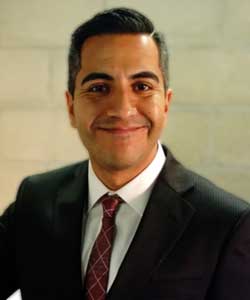The recipient of the 2019 Nevada Medal for Distinguished Graduate Student Paper in Bridge Engineering is David E. Duck, a doctoral student at the University of California, San Diego.

David Duck, doctoral candidate at UC San Diego and 2019 Nevada Medal winner.
The Nevada Medal is an annual award given to a graduate student paper that has made significant contributions to the state-of-the-art in bridge engineering.
The title of the winning paper is "Loading Apparatus for Characterising the Plastic Buckling-Straightening Fatigue Life of Large Diameter Reinforcing Steel Bars."
Typical bridge columns often incorporate large diameter reinforcing steel bars. Plastic hinging of the columns under strong earthquakes is associated with large strain reversals causing low-cycle fatigue, an effect that has not been studied in large diameter bars due to limitations of testing equipment and methods. The study reported in the paper effectively addressed these limitations. Duck's research that led to the award winning paper has been directed by Professor Jose Restrepo.
The winning paper was selected by a group of experts in bridge engineering research and design. The award includes a plaque, an engraved 14-K gold-plated pin and a $1,500 check. The funding for the award was initially provided through an endowment established by Simon Wong Engineering of San Diego, California. Wong completed a BSCE ('79) and an MSCE ('84) degree in civil engineering at the University of Nevada, Reno. The current sponsor of the award is the Civil & Environmental Engineering Department at the University.
"I am truly humbled and encouraged to be the recipient of this prestigious award and would like to thank the Civil Engineering Department at UNR, and all the committee members, for believing my work to be worthy of such high honor," Duck said. "Performing the experimental work described in this paper was extremely challenging and taxing, but receiving this award is very encouraging to continue striving for excellence in the field of bridge engineering."
Duck intends to continue his work to develop innovative processes and designs to further expedite the construction of cost-effective and safe bridges. He intends to employ existing and emerging technologies, such as sustainable concrete and 3D printing towards this goal.
Loading Apparatus for Characterising the Plastic Buckling-Straightening Fatigue Life of Large Diameter Reinforcing Steel Bars
Abstract: Critical regions of reinforced concrete elements designed for ductility and energy dissipation are required to sustain many large-amplitude strain cycles during rare and strong intensity earthquakes. Steel reinforcing bars in such critical regions often buckle and then fracture in a mode of failure that defines the collapse prevention limit state. This paper describes the design, implementation, and instrumentation of a loading apparatus used to test large-diameter reinforcing bars under large strain cyclic reversals. Main features of the loading apparatus include the high rotational stiffness and innovative use of the thermoplastic properties of sulfur concrete as part of the gripping mechanism.










